Ducks are a common sight in Alaska, and there are many different types of ducks to be seen. Some people may only know the common mallard, but there are dozens of other species of duck that can be found in Alaska.
We’ll take a look at some of the different types of ducks that can be found in the state. We’ll also discuss their behavior and what you might see them doing.
So if you’re interested in learning more about Alaskan ducks, keep reading!
What Ducks Are in Alaska?
There are 39 documented species of ducks in the state of Alaska.
Barrow’s Goldeneye
Bufflehead
Canvasback
Cinnamon Teal
Common Goldeneye
Gadwall
Garganey
Mallard
Northern Shoveler
Redhead
Ring-necked Duck
Smew
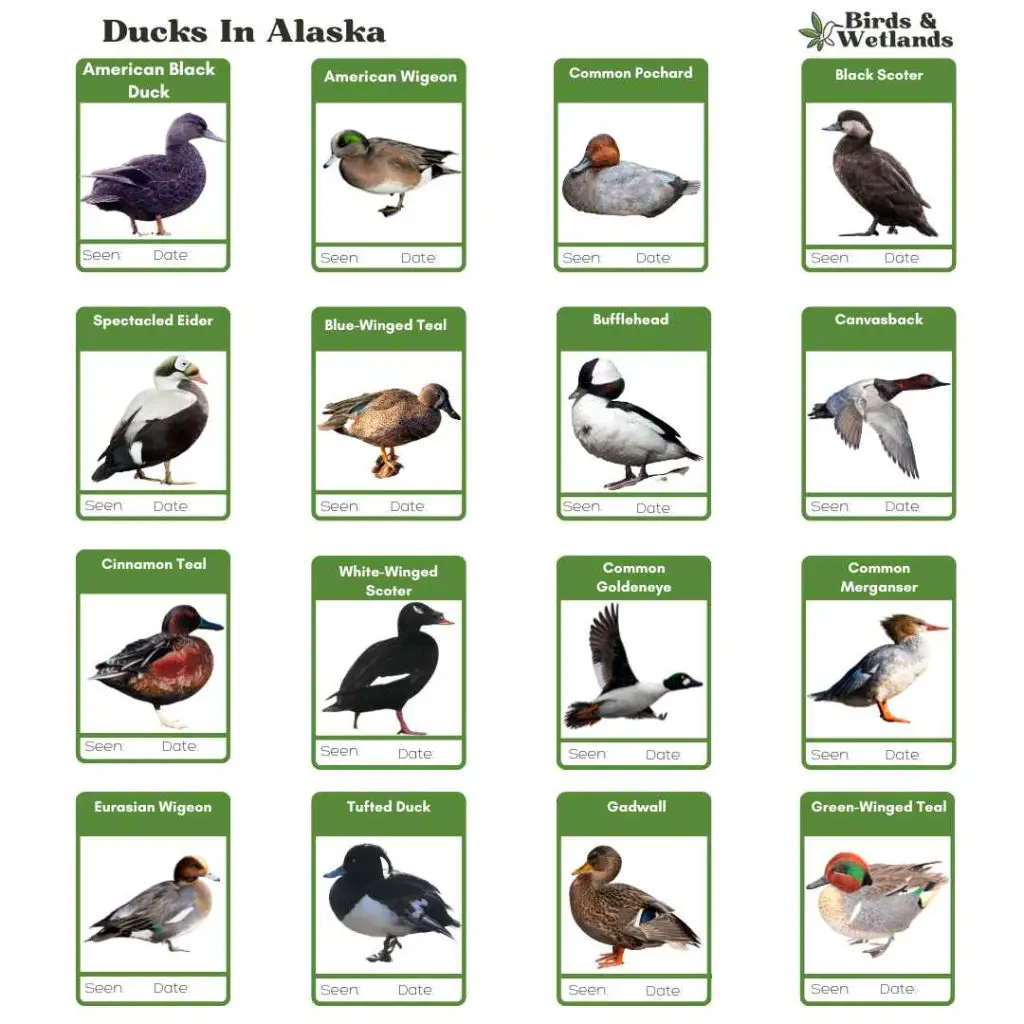
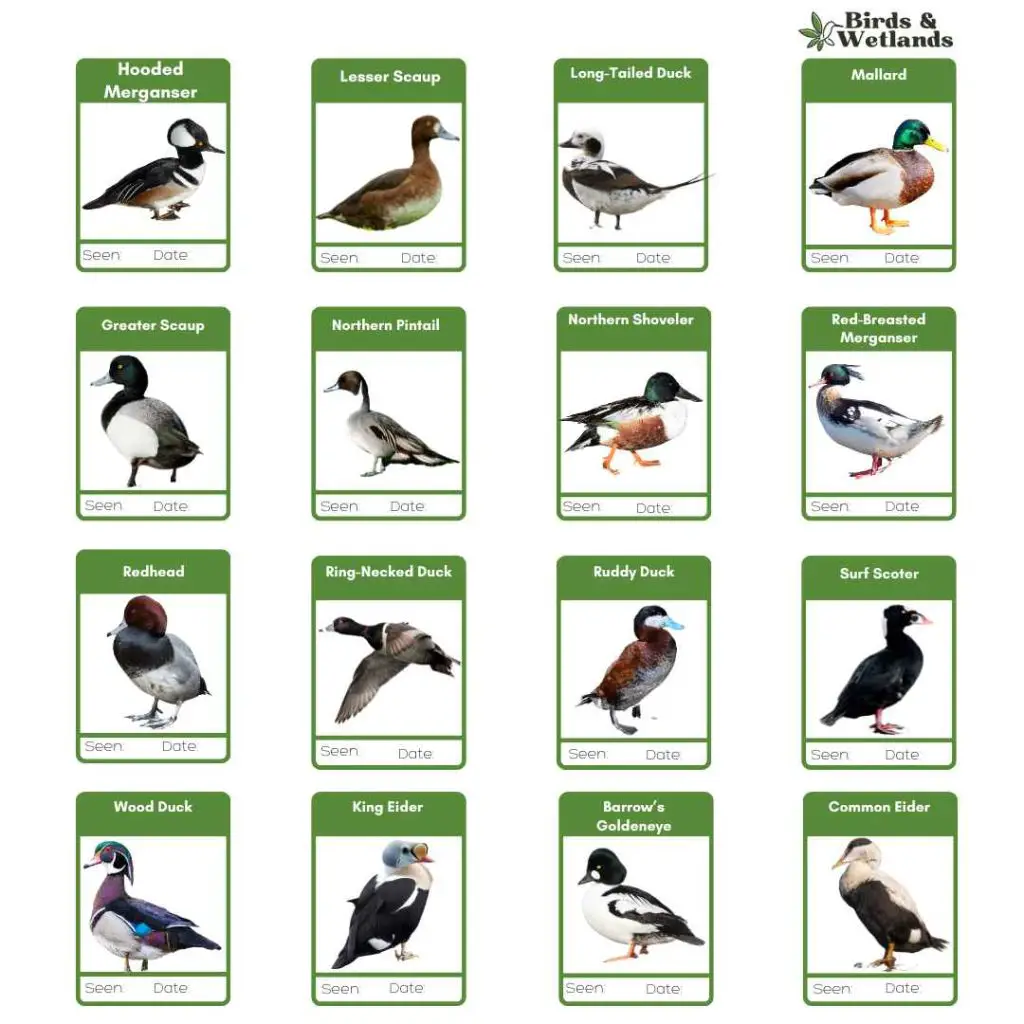

Alaska is located in the northwestern region of the United States and is known for its stunning natural beauty and wildlife. The state is home to a wide range of duck species, including the striking Barrow’s Goldeneye and the colourful Harlequin Duck. To the south of Alaska is the state of Washington, where the wetlands and estuaries provide a home for ducks including the Northern Shoveler and the American Wigeon.
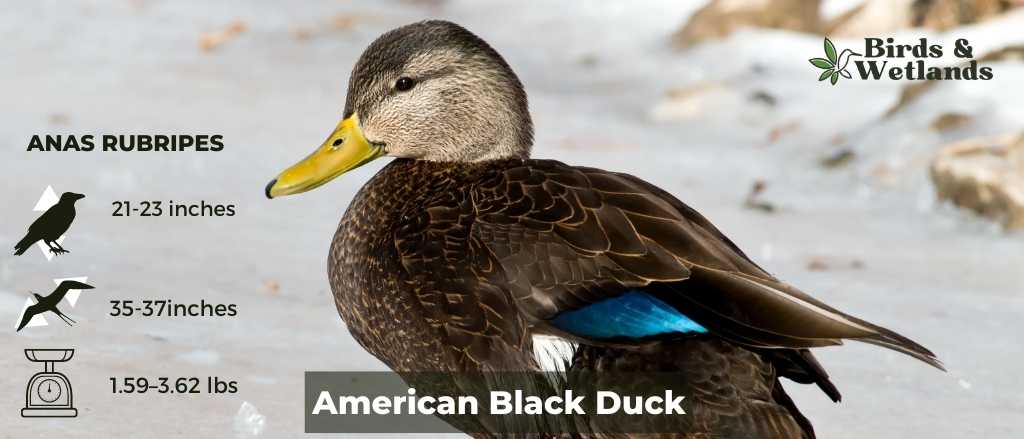
American Black Duck
Listen to American Black Duck
The American black duck belongs to the Anatidae family of big dabbling ducks. American Black Ducks are easily identified by their black plumage and white markings on the face and wingtips.
The males also have an orange bill with a black tip while females have dark gray bills with white spots on top. Both sexes have dark gray legs and feet which help them blend in with their surroundings.
They are omnivores, but mainly eat aquatic plants such as algae and duckweed. They also eat insects, small fish, snails, and seeds from land plants like clover or grasses which grow near bodies of water where they live.
The habitat for the American Black Duck is ponds and lakes in North America, Europe, Asia, and Australia. They are migratory birds and breed in northern regions like Alaska, Canada, and the northern United States. They have been known to nest on islands or in tree cavities when they cannot find a suitable wetland habitat.
The current population of the American Black Duck is estimated to be around 1 million birds.
Scientific Name: Anas rubripes
Height: 54–59 cm (21–23 in)
Wingspan: 88–95 cm (35–37 in)
Weight: 720–1,640 g (1.59–3.62 lb)
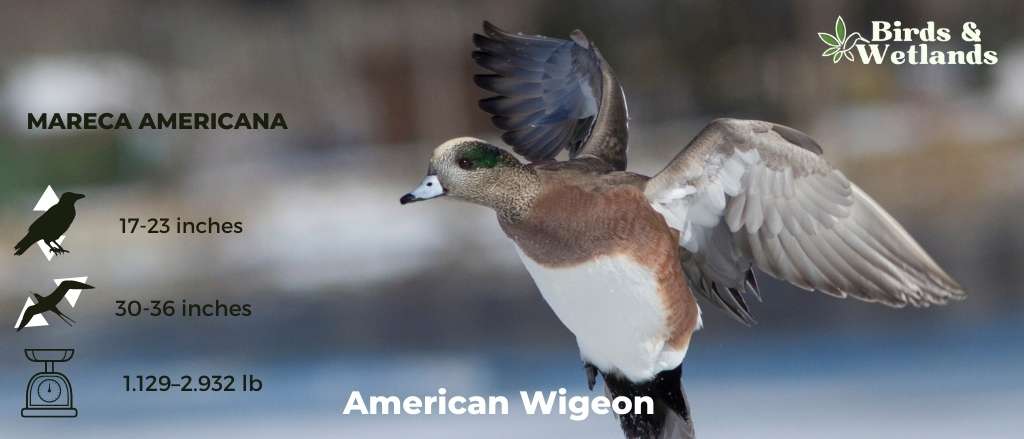
American Widgeon
Listen to American Wigeons
The American Wigeon, also known as the baldpate, is a medium-sized duck that is native to North America, Europe, Asia, and northern Africa.
American Wigeon is known for its bright plumage: males have a blue head and neck with a white breast and belly; females have a brown head with a white eye stripe and yellowish markings on the breast and belly. They also have short legs with two toes on each foot which enable them to walk easily on land or water.
Their diet consists of aquatic vegetation and seeds. They mainly eat aquatic plants, but also take some small invertebrates such as insects or snails from the water’s edge.
This species prefers areas with dense vegetation because they provide an excellent source of food for these birds during the breeding season (i.e., they can feed on aquatic plants). They are usually found in freshwater marshes, ponds, lakes, and river deltas.
They are not migratory and typically remain at the same location year-round. The current population of this bird is estimated at around 2 million individuals worldwide.
Scientific Name: Mareca americana
Height: 42–59 cm (17–23 in)
Wingspan: 76–91 cm (30–36 in)
Weight: 512–1,330 g (1.129–2.932 lb)
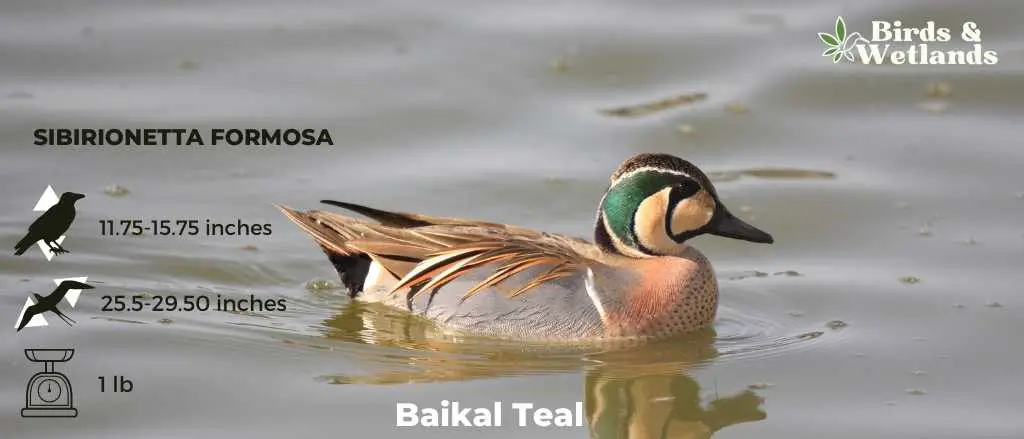
Baikal Teal
Listen to Baikal Teal
The Baikal Teal is a small duck that has a long, slender bill with a black tip, and its tail is short and slightly rounded. The male’s head and neck are blue-gray, and the rest of the body is an olive color with darker brown stripes. The female’s head is brownish gray, and its body is grayish-green with light brown markings.
Baikal teals can migrate thousands of miles each year to follow their food supply; they spend winters in coastal areas where they feed on marine life like fish eggs and crustaceans. They also eat small fish when necessary to survive harsh winters when there are no other food sources available for them to eat. They eat seeds from aquatic plants and insects found in lakes or ponds during their migration periods.
Baikal Teals are migratory birds that travel between Siberia, Alaska, and Canada during their breeding season. When these birds migrate, they can be found in China and Japan.
It is currently listed as “Least Concern” by the IUCN Red List due to its large population size and stable population trend.
Scientific Name: Sibirionetta formosa
Height: 11.75 to 15.75 inches
Wingspan: 65–75 cm
Weight: 1 pound
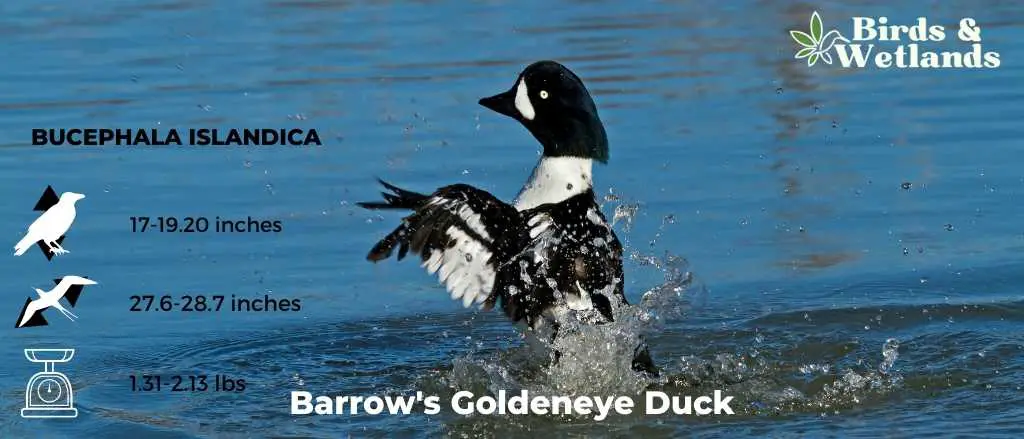
Listen to Barrow’s Goldeneye Duck
The Barrow’s Goldeneye Duck is a medium-sized diving duck with a black head and neck, a white breast, a brownish-gray back and sides, grey wings, and a white belly. It has a long, black, narrow bill that is slightly upturned at the tip.
The Barrow’s Goldeneye Duck has a diet of aquatic insects, mollusks, crustaceans such as shrimp or crayfish, and small fish.
These ducks live in both saltwater and freshwater habitats, where they breed during the springtime. They are migratory birds, traveling south during the winter months to spend time in warmer climates.
The Barrow’s Goldeneye Duck is found in the northern hemisphere from Alaska to Greenland, Europe, Asia, and northern Africa. In North America it breeds in Canada and Alaska; in winter it can be found south of California and New York.
Scientific Name: Bucephala islandica
Length:
Male: 19.2 in (49 cm)
Female: 17 in (43 cm)
Wingspan: 27.6-28.7 in (70-73 cm)
Weight:
Male: 2.13 lb (970 g)
Female: 1.31 lb (590 g)
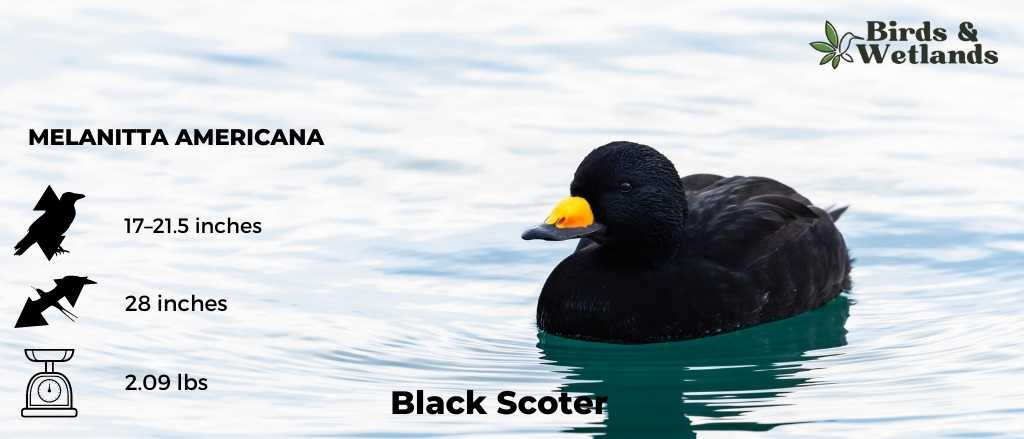
Black Scoter
Listen to Black Scoter
The black scoter, or American scoter, is a large duck, that breeds in the far north and winters in fresh water. These birds can be found in North America, Europe, Asia, Greenland, Iceland, and northern Russia.
It is dark brown with a white belly, black chest, and white feathers on its flanks. The male is larger than the female, though both sexes are similar in size. The eye is yellowish-orange with a dark ring around it. The legs are yellow.
They breed in small ponds with deep water, since they prefer to nest in freshwater lakes and rivers rather than saltwater lakes. Their diet consists mainly of fish and crustaceans, aquatic plants including algae, tubers, and seeds, as well as some insects when available.
It is a migratory bird that spends most of its time at sea, but it travels to land on migration routes during spring and fall.
The current population of this species is estimated at 1 million individuals worldwide; however, there are concerns about its future because many of its populations are declining due to habitat loss caused by climate change and pollution.
Scientific Name: Melanitta americana
Length: 430–550 mm (17–21.5 in)
Wingspan: 710 mm (28 in)
Weight: 950 g (2.09 lb)
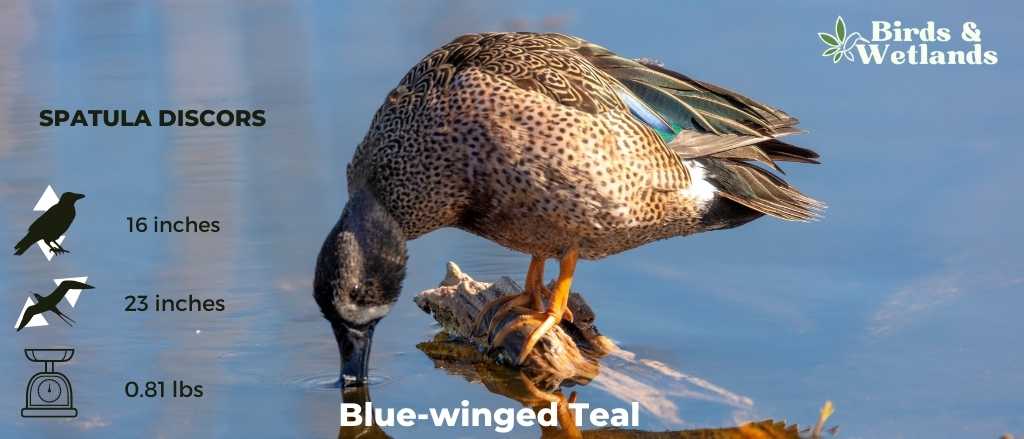
Blue-winged Teals
Listen to Blue-winged Teals
The Blue-winged Teal is a small duck that lives in North America. It has a glossy blue-gray head and back, with a white breast and sides. Its wings are dark brown with two white stripes, and its tail is also dark brown with white edges.
The Blue-winged Teal’s diet consists mostly of aquatic plants like pondweed, but it will also eat insects when they are available. This duck often feeds by pecking at the surface of the water rather than diving for food. It will sometimes form small groups to feed together or fly in single file formation when migrating south for winter.
Blue-winged teals are found in marshes, ponds, lakes, and rivers throughout the United States south of Canada, and north of Mexico.
They are migratory birds and fly south for the winter months to warmer climates. It winters along the Atlantic coast from southern New England to Virginia and then moves further south as far as Mexico.
Scientific Name: Spatula discors
Height: 40 cm (16 in)
Wingspan: 58 cm (23 in)
Weight: 370 g (13 oz)

Bufflehead
Listen to Bufflehead
The Bufflehead is one of the most striking birds in North America. It is a small duck with a pale head, a black breast, and a white belly. It has a black head and neck, white patches on the cheeks and throat, and a distinctive white crescent on each side of its tail. The female has a darker head than the male.
The Bufflehead is a strong flier, but rarely flies more than several hundred yards at a time. It lives on the coast of North America, spending most of its time in salt water.
Buffleheads can eat many different types of foods including clams, crayfish (also known as crawfish), insects such as beetles and flies as well as other small animals such as mice or voles (small rodents). It also feeds on insects and crustaceans found along the bottom of streams or lakes, as well as small fish such as minnows or suckers.
Buffleheads spend most of their time in freshwater habitats such as lakes, ponds, rivers, estuaries, and bays. They are able to survive in such diverse environments because they are excellent swimmers and divers. They are quiet ducks except in the late winter to early spring.
Scientific Name: Bucephala albeola
Length: 32–40 cm (13–16 in)
Wingspan: 21.6 in (55 cm)
Weight: 270–550 g (9.5–19.4 oz)
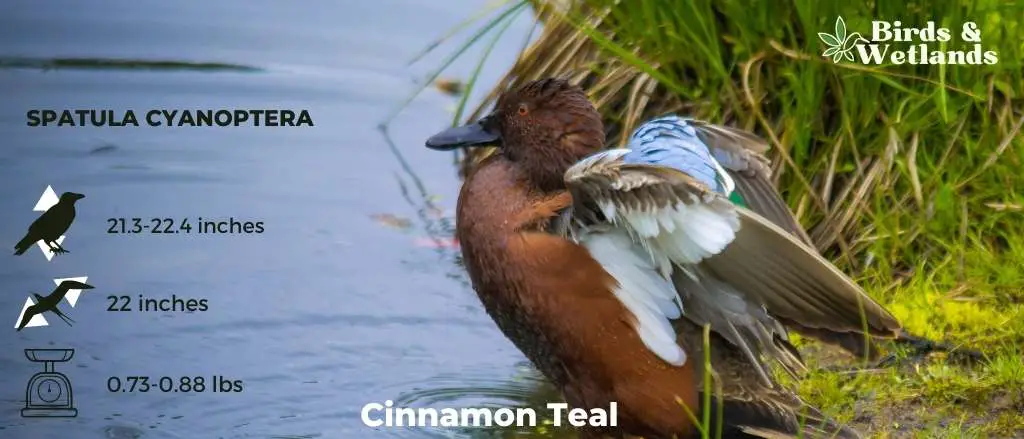
Cinnamon Teal
Listen to Cinnamon Teal
Cinnamon Teal is a small duck with distinctive bright cinnamon-colored feathers on its back and white markings above the eye that is native to North America and Central America.
The diet of this bird includes seeds, insects, and other invertebrates that are found near water sources where they live. Like most ducks, it feeds on aquatic vegetation such as pondweed, watercress, pondweed, and water lilies. This bird has also been known to eat insects and small crustaceans.
They are found in the northern hemisphere and are particularly common in North America, where they breed from Alaska to Canada. They winter south of the U.S., as well as in parts of Mexico and Central America.
The Cinnamon Teal is a very social bird, often living in large flocks during the mating season and congregating around lakes and rivers during migration. They tend to be shy and elusive, so it can be difficult to see them in their natural habitat.
These birds mate for life and build nests on the ground near water sources—usually shallow ponds or marshes with tall grasses nearby for cover when young are being reared.
Scientific Name: Spatula cyanoptera
Height: 21.3-22.4 in (54-57 cm)
Wingspan: 22-inch (560 mm)
Weight: 11.8-14.1 oz (335-401 g)
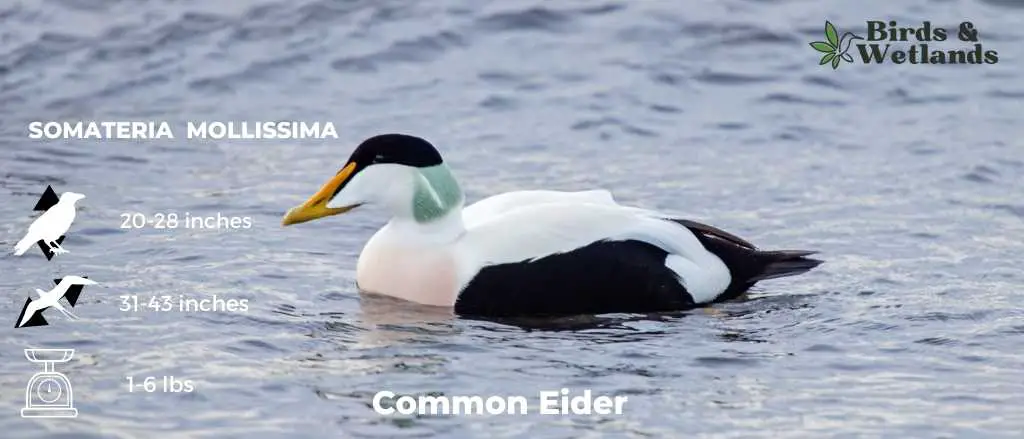
Common Eider
Listen to Common Eider
The common eider, sometimes known as the Cuddy’s duck or St. Cuthbert’s duck, is a huge sea duck with a round head and a thick neck found throughout the northern shores and tidal flats of Europe, North America, and eastern Siberia.
Common eiders have a long, rounded tail and a distinctive white patch at the base of the bill. Their plumage is predominantly black and white, with brownish-gray on their wings and back.
They prefer to live in shallow waters where they can dive for food easily. They feed on fish, mollusks, crustaceans, and other marine life. They are also known to eat dead fish found near shorelines. In winter, they can be found near open water such as estuaries or sheltered bays where there is access to ice floes for resting and feeding.
Common Eiders have several unique characteristics that make them stand out from other birds of their kind. Their legs are positioned so that when swimming underwater they can rotate their feet 180 degrees without having to lift them above the water’s surface.
They breed on coastal tundra lakes in northern Canada and Alaska. The population of Common eiders has been steadily declining over the years due to habitat loss caused by human activities such as logging operations, which destroy nesting habitats for these birds each year.
Scientific Name: Somateria mollissima
Length: 50–71 cm or 20–28 in
Wingspan: 80–110 cm (31–43 in)
Weight: 0.81 to 3.04 kg (1 lb 12+1⁄2 oz to 6 lb 11 oz)

Common Goldeneye Duck
Listen to Common Goldeneye Duck
The common goldeneye, often known as the goldeneye, is a medium-sized duck belonging to the Bucephala genus. The Barrow’s goldeneye is its closest cousin. It has a distinctive yellow bill and a white face.
These sea ducks have two different color patterns on their wings: one side is brown and the other is black. Their tail feathers are also brown and black in coloration.
Goldeneyes are also known for their unique calls. It sounds like a squeaky rubber toy being squeezed repeatedly. This makes them easy to identify by ear in addition to sight!
They are one of the most abundant ducks in North America, and they can be found in lakes, ponds, rivers, and marshes. The Common Goldeneye Duck prefers to live near shorelines where there are plenty of fish and vegetation available for food sources, but they can also be found living further inland near ponds or wetlands if necessary.
The Common Goldeneye Duck is listed as “least concern” by the International Union for Conservation of Nature (IUCN), which means that it isn’t threatened with extinction
Scientific Name: Bucephala clangula
Length:
Male: 45–51 cm (18–20 in)
Female: 40–50 cm (16–20 in)
Wingspan: 30.3-32.7 in (77-83 cm)
Weight:
Male: 1,000 g (2.2 lb)
Female: 800 g (1.8 lb)

Common Merganser
Listen to Common Merganser
The common merganser, sometimes known as the goosander, is a huge sea duck found in wooded parts of Europe, Asia, and North America.
They have a long bill that is pointed at the end and has a black tip on it. Their plumage is mostly dark with a white underside. They have very large feet and webbed toes to help them swim. Their legs are long and slender as well. The female has a grayish-white body.
Common mergansers are omnivores, eating both plants and animals such as small fish or insects. They eat their prey by diving underwater and spearing it with their long bill before swallowing it whole.
The habitat of this bird is lakes, rivers, ponds, and marshes. They prefer quieter bodies of water with plenty of vegetation along the shores where they can rest during the day before moving on to hunt at night.
The current population of this bird is considered stable due to its ability to thrive even when there are threats present due to its adaptability as well as its wide range across North America.
Scientific Name: Mergus merganser
Length: 58–72 cm (23–28+1⁄2 in)
Wingspan: 78–97 cm (30+1⁄2–38 in)
Weight: 0.9–2.1 kg (2 lb 0 oz – 4 lb 10 oz)

Eastern Spot-billed Duck
Listen to Eastern Spot-billed Duck
The Eastern Spot-billed Duck is a small species of waterfowl that is native to eastern Asia. It is one of the most colorful ducks in the world, with a bright white body, orange bill and feet, and black spots on its chest. They have a yellow bill with red markings near the tip of it.
This duck’s diet consists primarily of aquatic plants such as water lilies, watermilfoil, water hyacinths, arrowheads, and bulrushes; however, it can also eat insects such as dragonflies, mayflies and cockroaches, and small fish if necessary. Because they are omnivores, they are able to eat both plant matter and animal protein.
Its habitat consists of freshwater lakes, ponds, and rivers in forested areas throughout Southeast Asia, China, Korea, and Japan.
The Eastern Spot-billed Duck currently has a population size of roughly 50 million birds. This number is growing every year due to conservation efforts by organizations such as BirdLife International. It is currently classified as “least concern” by the IUCN Red List of Threatened Species due to its wide range of distribution across several countries as well as its stable population trend over time.
Scientific Name: Anas zonorhyncha
Height: 55–63 cm (22–25 in)
Wingspan: 83–95 cm (33–37 in)
Weight: 790–1,500 g (1.74–3.31 lb)
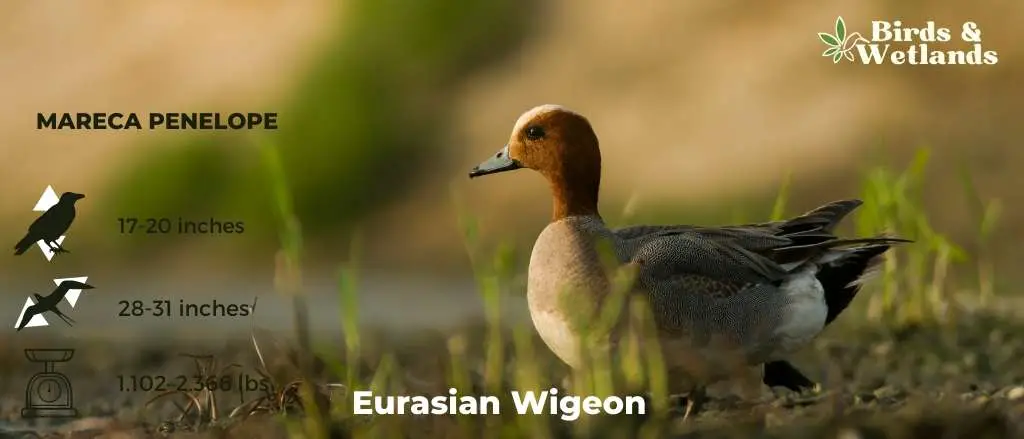
Eurasian Wigeons
Listen to Eurasian Wigeons
The Eurasian Wigeon, or European Wigeon, is a medium-sized duck with a long, pointed bill and a distinctive white crescent on the side of its face. The male has a light brown body with a dark green head and white cheek stripes on either side of its face. The female has a lighter brown body with a black head and white cheek stripes on either side of its face.
The diet of these ducks consists of vegetation such as roots, bulbs, tubers, and rhizomes from aquatic plants such as sedges, bulrushes, and other grasses as well as insects such as dragonflies or water boatmen. In wintertime, they feed on aquatic plants like duckweed or reeds in shallow water.
They are found in central and eastern Europe, Scandinavia, Russia, China, Korea, Japan, north-east Siberia and Alaska. They migrate between their breeding range in central Asia and southern Europe. They prefer nesting near lakes or ponds but they can also be found nesting on small streams.
The current population of Eurasian Wigeons is estimated at around 1 million birds worldwide with populations declining in many areas due to habitat loss.
Scientific Name: Mareca penelope
Height: 42–52 cm (17–20 in)
Wingspan: 71–80 cm (28–31 in)
Weight: 500–1,073 g (1.102–2.366 lb)

Falcated Duck
Listen to Falcated Duck
The Falcated Duck is a species of duck that lives in the wilds of North America, Canada, and Alaska making its home in the Pacific Northwest.
It has long legs and wings, making it one of the fastest ducks on earth. Its bill is also distinctive, with a downward curve at the end. Their legs are pinkish-grey and they have reddish-orange eyes. Their bills are a yellowish-green color with black tips. They also have a white stripe down their neck to their chest.
They’re omnivorous – eat aquatic plants and seeds, and animals. but on average they eat about 70% animal matter (like insects and small fish). It forages for food by diving underwater or dabbling at the surface, sometimes upending completely to reach roots or plant stems growing close to the surface of the water.
This duck is notable for its very distinctive bill and its unusual nesting habits—instead of building a nest that it sits on, this duck lays its eggs in shallow water and lets them incubate naturally. They are very social animals and live in small groups called “trios” or “flocks” during the breeding season (which lasts from mid-April to early July).
The Falcated Duck is a globally threatened species due to hunting pressure from humans who seek its meat as well as habitat loss due to drainage of wetlands where they breed and overwinter.
Scientific Name: Mareca falcata
Height: 46 to 53 cm (18–21 in)
Wingspan: 79 to 91 cm (31–36 in)
Weight: 422 to 770 g (14.9–27.2 oz)
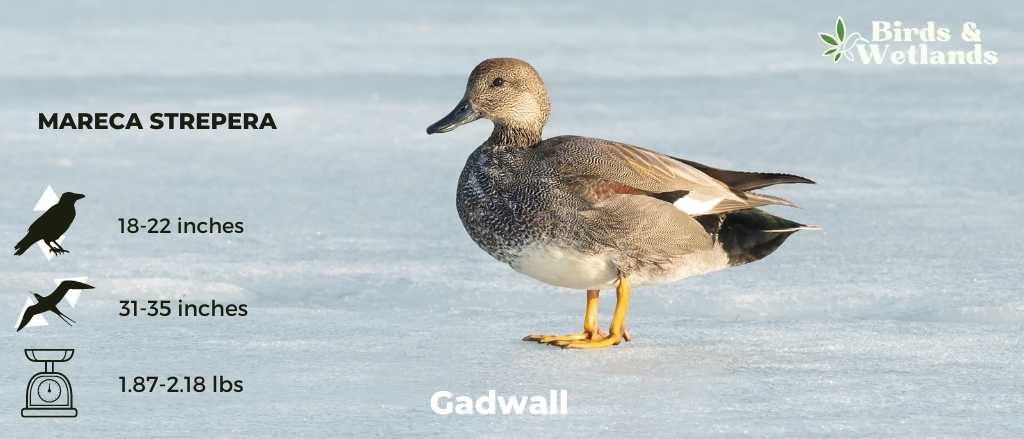
Gadwall
Listen to Gadwall
Gadwall is a duck that’s known for its yellow bill and the white patch on its cheek. It is native to North America, Europe, and Asia. It has a black head and breast, white cheeks, and a buff-colored body. The male’s bill is yellow with a dark tip.
The Gadwall’s color varies depending on its location—in North America, they are a dull brownish-gray, while in Europe their feathers are more of a chestnut brown. Their bills are black with a white tip, and their legs are yellowish-green above black webbed feet.
The only thing that sets them apart from other ducks is their eyes: they have dark brown eyes with a distinctive red circle around them.
Gadwalls are slightly smaller than mallards, with males weighing between 2 and 3 pounds and females weighing between 1.5 and 2 pounds.
These small ducks eat insects, worms, crustaceans like crayfish, frogs, and tadpoles as well as small fish when available. They will also eat seeds from grasses and plants like watercress
The Gadwall’s habitat is near water; it can be found in marshes, rice paddies, ponds, and lakes.
Gadwalls breed in northern North America and in Europe as far east as Siberia. They also breed in Asia where they are found in Japan, Korea, and China as well as Mongolia and Siberia.
They are migratory birds that fly south in the winter to warmer climates. They migrate south to winter in the southern USA, Mexico, and Central America as well as southern Europe (Spain), Central Africa (Ethiopia), and India. They are usually found in pairs or small flocks during migration and breeding season but tend to be solitary during winter months when they migrate southward.
This species of duck has experienced an increase in population over the last 100 years due to conservation efforts by governments and organizations such as Ducks Unlimited Canada (DUC).
Scientific Name: Mareca strepera
Height: 46–56 cm (18–22 in)
Wingspan: 78–90 cm (31–35 in)
Weight
Male: 990 g (35 oz)
Female: 850 g (30 oz

Garganey
Listen to Garganey
Garganey is a small duck with a slender body, long neck, and short bill. It has a black head, neck, and upperparts. The breast is white with dark spots in the center of each feather. The flanks are brownish-gray and the belly is white. The legs and feet are orange-yellow.
The Garganey feeds on insects, mollusks, fish, frogs, and worms. It nests near water, where it can be seen diving for food with its bill pointed downward.
The garganey’s habitat includes shallow freshwater lakes, ponds, and marshes with reeds or other tall vegetation near them. They live in flocks during the breeding season but tend to be solitary during migration and winter months.
It breeds over most of Europe and the Palearctic, as well as northern Asia and North America but it is purely migratory, with the whole population migrating to Southern Africa, India, Bangladesh, and Australasia during the Northern Hemisphere winter, when vast flocks may be seen.
The garganey is listed as Least Concern by IUCN due to its large range estimated at 1 million km2 (390 000 mi2).
Scientific Name: Spatula querquedula
Height: 41 cm
Wingspan: 58 – 69 cm
Weight: 300- 440 g

Greater Scaup
Listen to Greater Scaup
The Greater Scaup is a large diving duck with a distinctive white band on its head. The rest of its body is brown with a blue-grey sheen on its back and tail (which can be seen when they fly). The male is larger than the female, with a more pronounced bill and more white wing feathers. It has a black bill, black feet and legs, and gray plumage.
They prefer shallow water close to shore where they can feed on aquatic vegetation and small fish. They are omnivorous creatures who feed on mollusks, crustaceans, insects (especially water beetles), worms, and other small invertebrates like larval dragonflies which comprise about 60% of their diet.
This species breeds in the northern taiga regions of Canada and Alaska and winters in the Atlantic and Pacific Oceans, as well as some inland lakes. It is an uncommon sight in North America but can be found in many areas across Europe, Asia, Africa, and Australia. In winter, it migrates to southern Canada and parts of the northeastern United States.
Scientific Name: Aythya marila
Height: 39–56 cm (15–22 in)
Wingspan: 71–84 cm (28–33 in)
Weight: 726–1,360 g (1.601–2.998 lb)

Harlequin Duck
Listen to Harlequin Duck
The Harlequin Duck is a beautiful small duck that is native to North America. It has a unique appearance. It has a black head, neck, and breast, with white cheeks and sides of the neck, and red eyes. The body is black with white spots on the wings and tail feathers.
In addition to being unique-looking birds, these sea ducks are also very vocal animals who make sounds such as whistles and squeaks that can be heard from up to 100 yards away! These sounds are used primarily for communication between other ducks within a flock but can also be used to alert predators of danger if needed (such as when approaching land).
These birds feed on small fish and crustaceans such as shrimp and clams. They can dive up to 20 feet below the surface to catch their prey.
It can be found in coastal areas of North America, Europe, and Asia, where it lives in salt marshes. It lives in freshwater lakes, ponds, and rivers. The species is monogamous and breeds in April and May.
Unfortunately, these beautiful creatures are currently under threat from habitat loss due to human development as well as overfishing.
Scientific Name: Histrionicus histrionicus
Length: 15–17 in (380–430 mm)
Wingspan: 26 in (660 mm)
Weight: 600 g (1.3 lb)

Hooded Merganser
Listen to Hooded Merganser
The hooded merganser, also known as the hooded duck, is a species of duck that lives in North America. It has a black head and a brown back. It has two different colored eyes: one brown and one yellow-orange, which are always open.
The Hooded Merganser is a relatively small duck with a slender body and a long tail. It has a white breast and belly, as well as a black cap and crest, which creates the illusion of the bird wearing a hood.
Hooded Mergansers eat mostly fish—they dive underwater to catch them! They also eat crayfish, crustaceans such as shrimp or krill, frogs, snails, and insects such as dragonflies or grasshoppers when they are unable to find enough food near the surface of water bodies.
The Hooded Merganser lives in North America and spends most of its time in freshwater ponds, lakes, and rivers during the spring breeding season. It moves to saltwater marshes during the winter months to avoid freezing temperatures.
The Hooded Merganser is currently listed as Least Concern by the IUCN Red List because its population is stable or increasing and it has a large range.
Scientific Name: Lophodytes cucullatus
Length: 15.8-19.3 in (40-49 cm)
Wingspan: 23.6-26.0 in (60-66 cm)
Weight: 16.0-31.0 oz (453-879 g)
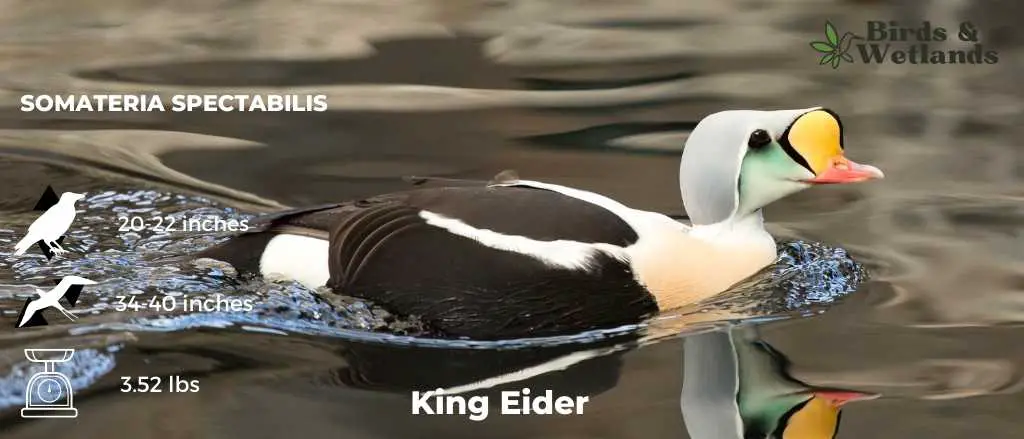
King Eiders
Listen to King Eiders
This large duck breeds in Arctic and sub-Arctic regions from Alaska to Greenland and along most of the northern Hudson Bay shoreline.
It is so named because of its magnificent crest, which it can raise or lower at will. It has a stocky body, a large head, and a short neck. Its plumage is brownish-gray on the back and sides, with a white belly and chest.
It prefers breeding grounds near the sea, where they can feed on mussels and other shellfish. They also eat small fish and crustaceans.
This species is found in coastal areas near water during the summer months, but it will migrate during winter months to coastal areas away from ice sheets where it can find food. They typically live about 15 years in the wild but have been known to live up to 35 years in captivity.
This bird can dive to depths of about 30 meters for over 30 seconds at a time in search of food such as small fish or mollusks.
The king eider is listed as Vulnerable by Birdlife International because its population has declined by more than 10% since 1980 due to overhunting in some parts of its range.
Scientific Name: Somateria spectabilis
Height: 52–57 cm (20–22 inches)
Wingspan: 86–102 cm (34–40 in)
Weight: 1.6 kg

Lesser Scaup
Listen to Lesser Scaup
The lesser scaup is a tiny diving duck native to North America that winters in along the west coast and Central America. It is a smaller version of the Greater Scaup, and it can be distinguished from that species by its black breast, which contrasts with the white breast of the Greater Scaup.
They are one of the most abundant waterfowl in North America and are found across Canada and the United States. Because of its unusual blue bill, it is also called the small bluebill or broadbill.
The Lesser Scaup’s habitat is typically freshwater lakes, rivers, and streams. They can also be found on large ponds and reservoirs with plenty of aquatic vegetation.
Lesser Scaups eat mostly fish but also insects and small crustaceans, which they find by diving beneath the surface of the water for up to 40 seconds at a time. They are very territorial birds, so you may see several males fighting over territory during the breeding season.
Lesser scaups breed in ponds and lakes across Canada and much of the northern United States from late April through May. They usually nest in colonies with other species such as mallards or common goldeneyes.
The Lesser Scaup is not considered to be endangered or threatened and is currently listed as Least Concern by the International Union for Conservation of Nature (IUCN).
Scientific Name: Aythya affinis
Height: 41.7–43 cm (16.4–16.9 in)
Wingspan: 68–78 cm (27–31 in)
Weight: 454–1,089 g (1.001–2.401 lb)
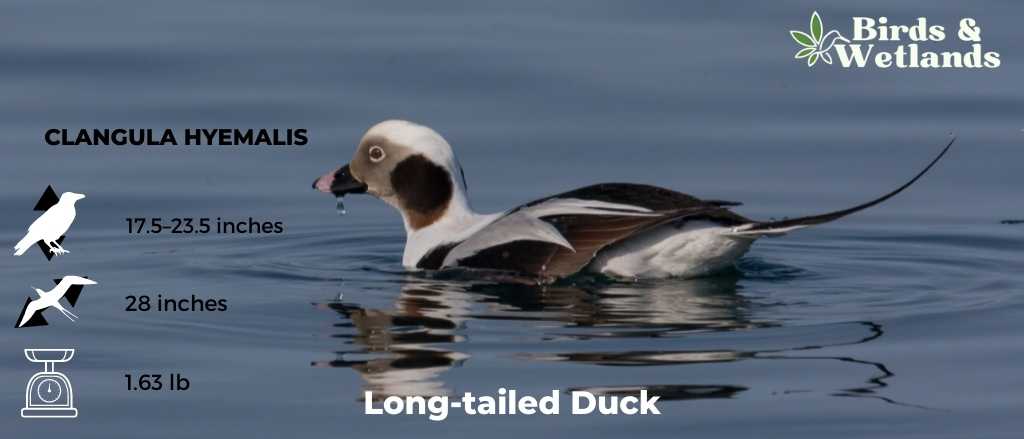
Long-tailed Duck
Listen to Long-tailed Duck
Long-tailed Ducks are species of duck that are native to Australia and New Zealand. They are named for their long, narrow tail feathers, which can be over 30% longer than the rest of their body. It has a black bill, brown eyes, and grayish-brown feathers on its back and wings. The underside of the bird is white in color.
The Long-tailed Duck eats aquatic plants, seeds, insects, snails, mollusks, crustaceans, fish eggs, and small fish. They can dive up to 60 feet below the surface.
These species of duck prefer to live in areas where there are plenty of lakes and ponds for them to feed on. They are also known for being very territorial so they tend not to share their space with other ducks unless they have no choice but to or if they’re trying to breed.
They are migratory birds, traveling from Canada to Europe during the summer months before returning south for winter months in North America or Asia.
They can be found in Europe, Asia, North America, and parts of South America. They breed in freshwater lakes from May through July or August depending on where they live. They migrate to southern latitudes during the winter months to avoid freezing temperatures.
Long-tailed Ducks have a current population of roughly 2 million individuals worldwide—that’s down from an estimated 4 million during the 1980s.
Scientific Name: Clangula hyemalis
Length: 440–600 mm (17.5–23.5 in)
Wingspan: 710 mm (28 in)
Weight: 740 g (1.63 lb)

Mallard
Listen to Mallard
The Mallard is a small, wild duck that lives in the United States and Canada. It’s a duck that is native to the Northern Hemisphere. It has a beautiful green head and a brown body, and it’s known for its long, lobed tail feathers.
They have black bills and yellow feet, which makes them easy to identify. Males have purple patches on their wings, while females have mainly brown-speckled plumage. The female mallard is also known for its quack.
Their diet consists mostly of seeds, fruit, and insects. Mallards have been known to consume small rodents if they are available. They also eat frogs and fish when they can catch them. They usually feed at night in shallow water or on land near water sources.
Their habitat is primarily in wetlands such as ponds, lakes, and rivers. They also inhabit saltwater environments close to lands such as bays and estuaries.
They are also very social birds that travel in flocks during the breeding season and pair off into monogamous pairs during the winter months when they migrate southward to warmer climates where food sources are more plentiful.
Scientific Name: Anas platyrhynchos
Height: 50–65 cm (20–26 in)
Wingspan: 81–98 cm (32–39 in)
Weight: 0.7–1.6 kg (1.5–3.5 lb)

Northern Pintails
Listen to Northern Pintails
The Northern Pintail is an uncommon duck that can be found in North America and Europe. This duck is a medium-sized, strong-flying waterfowl with a long neck and tail.
Both sexes have grey legs and feet and blue-grey bills. A faint white stripe runs from the rear of the drake’s chocolate-colored head down its neck to its mainly white undercarriage, making it more noticeable.
The breeding male has flanks with excellent grey, brown, and black patterning. The hen’s plumage is more muted, with dull brown feathers that resemble those of other female dabbling ducks. The drakes emit a flute-like whistle, while the hens make a harsh quack.
The Northern Pintail is a migratory bird that nests on or near open water with some vegetation nearby. This bird feeds on aquatic plants such as bulrush roots, pondweeds, and sedges; seeds from different plants like grass; insects such as dragonflies; fish; other small animals such as mice or frogs; and worms, which are their favorite food source for survival (when they’re not eating seeds).
There are approximately 1 million Northern Pintails left in the wild today.
Scientific Name: Anas acuta
Height:
Male: 59–76 cm (23–30 in)
Female: 51–64 cm (20–25 in)
Wingspan: 80–95 cm (31–37 in)
Weight:
Male: 450–1,360 g (0.99–3.00 lb)
Female: 454–1,135 g (1.001–2.502 lb)

Northern Shovelers
Listen to Northern Shovelers
The northern shoveler, often known as the shoveler in the United Kingdom, is a common and ubiquitous duck. With its brown head and neck and breast, greenish-yellow bill and wings, white breast and belly, and the dark greenback, and black tail feathers, it’s hard to mistake for any other duck species.
These water birds live in freshwater ponds, marshes, lakes, rivers, and streams but will also sometimes inhabit brackish water areas where the water has a high salt content. It breeds in North America from Canada to Mexico, migrating south for the winter months.
The Northern Shoveler’s diet consists primarily of aquatic plants like duckweed and water lettuce. It also eats insects, worms, crustaceans, and mollusks if they can find them in the water.
Wintering in southern Europe, the Indian subcontinent, Southeast Asia, Central, the Caribbean, and northern South America, it breeds in northern Europe, through the Palearctic, and across much of North America.
Scientific Name: Spatula clypeata
Height: 16 in (41 cm)
Wingspan: 22-inch (560 mm)
Weight: 14 oz (400 g)
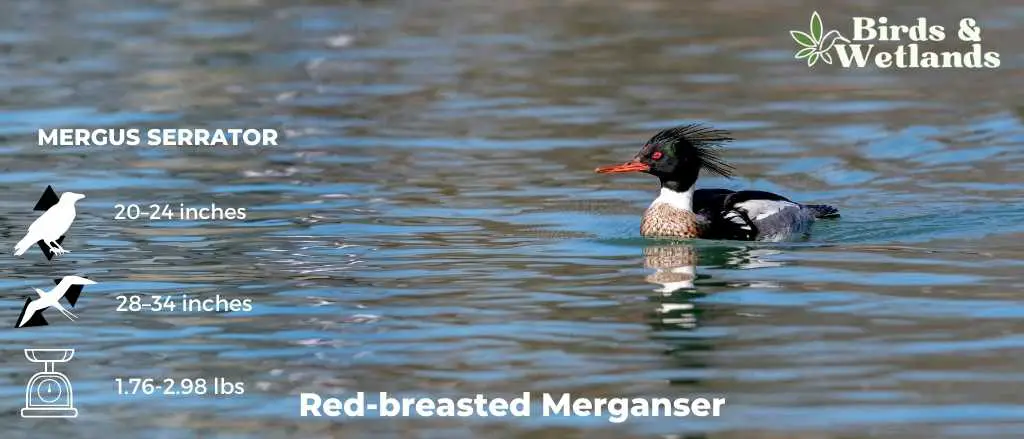
Red-breasted Merganser
Listen to Red-breasted Merganser
The Red-breasted Merganser has an appearance that makes it easy to identify. The feathers on their chest are red in coloration, and they have a white throat area. They are known for their bright red chests, which is what gives them their name.
This bird has a long body with a white underside and black head, neck, back, and tail. Its wings are brownish-grey and its bill is yellow with an orange tip.
They feed on fish by diving into the water using their wings to propel themselves forward like penguins do when swimming underwater. They also eat amphibians such as frogs or newts if they can catch them.
The habitat of this bird includes lakes, rivers, and ponds where they can dive into the water to catch fish while swimming underwater or dive from above the water to catch fish resting on the bottom of lakes or ponds.
This bird is not endangered or threatened at this time because it has a very large population of over 8 million birds worldwide.
Scientific Name: Mergus serrator
Length: 51–62 cm (20–24 in)
Wingspan: 70–86 cm (28–34 in)
Weight: 28.2 to 47.6 oz (800 to 1,350 g)

Ruddy Duck
Listen to Ruddy Duck
Ruddy Duck is a medium-sized diving duck that’s native to North America. They’re known for their ruddy, or reddish-brown coloration, which is most prominent during the breeding season. It has a white breast and white stripe on its face.
Ruddy Ducks are omnivorous, eating plants and insects as well as fish and small animals. It eats insects, grains, seeds, and aquatic plants. They are monogamous animals; they mate for life and have one clutch per year of 4-6 eggs that hatch after 25 days.
Ruddy Ducks frequently move in small groups of 5–15 birds at night. They’re also very sociable animals.
Ruddy Ducks live in freshwater lakes, ponds, rivers, marshes, and swamps. They are migratory birds that spend the winter in South America.
Ruddy Ducks are typically found in freshwater lakes and marshes during the breeding season (April through August), but they can also be seen on rivers or coasts during migration or wintering months (October through February).
Scientific Name: Oxyura jamaicensis
Length: 13.8-16.9 in (35-43 cm)
Wingspan: 22.1-24.4 in (56-62 cm)
Weight: 10.6-30.0 oz (300-850 g)

Smew
Listen to Smew
The smew is the sole extant member of the Mergellus genus. Mergellus is a diminutive of Mergus, while albellus is derived from the Latin word albus, which means “white”.
The male has a black face mask and thin black markings on the sides of his breast and flanks. The female has a dark reddish-brown head with a large white cheek patch and neck. The black-and-white appearance in flight is stunning.
They are omnivorous birds that feed on fish such as sticklebacks, perch, roach, insects, frogs, crustaceans, mollusks, worms, spiders, and small rodents, but they’ll also eat insects if they’re available.
The smew can be found in freshwater lakes, ponds, rivers, and marshes throughout Europe, Asia, and North America as far north as Alaska. They can also be found in Japan, China, and Korea where they have been introduced as well as in Canada where they have been introduced from Europe.
In terms of conservation status, there are no imminent threats currently facing this species.
Scientific Name: Mergellus albellus
Length: 38–44 cm (15–17 in)
Wingspan: 56–69 cm
Weight: 450–650 g
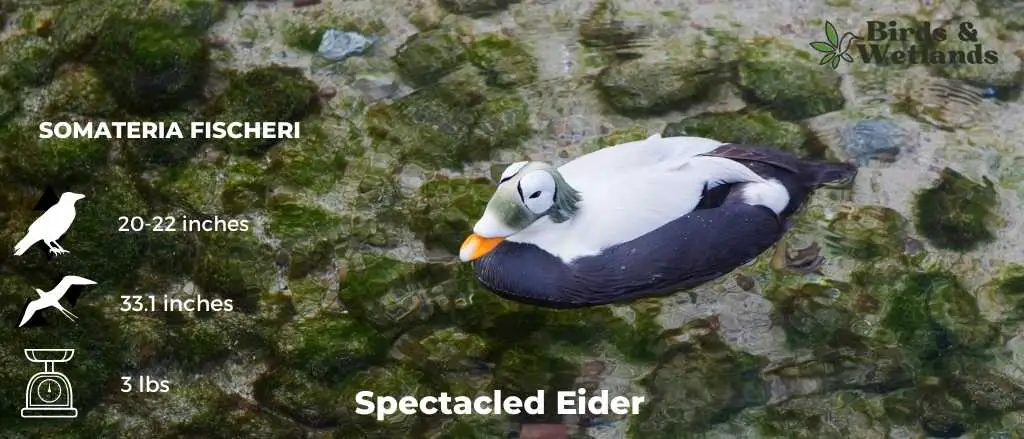
Spectacled Eider
Listen to Spectacled Eider
The Spectacled Eider is a medium-sized sea duck that can be found in the Pacific, Atlantic, and Arctic oceans. They are also known as the “eider duck” or “eider” due to their resemblance to the common eider.
They have a white face, dark eye ring around their eyes, black back, white belly, and a pale orange bill with a dark tip. The body of the bird is mostly brown with white markings on the wings and tail feathers.
The diet of the Spectacled Eider consists mostly of small fish and crustaceans such as crabs, shrimp, and shellfish. They are also known to eat insects such as flies when they can find them on land during migration time.
Wet tundra environments are the nesting grounds for spectacled eiders. They breed near Alaska’s and Russia’s Arctic shores, as well as the Yukon-Kuskokwim Delta in Alaska.
Spectacled Eiders are migratory birds that travel thousands of miles every year between their breeding grounds located in northern Russia and Alaska to spend winter months in southern California where they feed on mussels and other shellfish found along sandy beaches.
They are considered an endangered species by the IUCN Red List due to over-fishing for their down feathers which are used for pillows and comforters.
Scientific Name: Somateria fischeri
Height: 52–57 cm (20–22 inches)
Wingspan: 33.1 in (84 cm)
Weight: 3 lbs
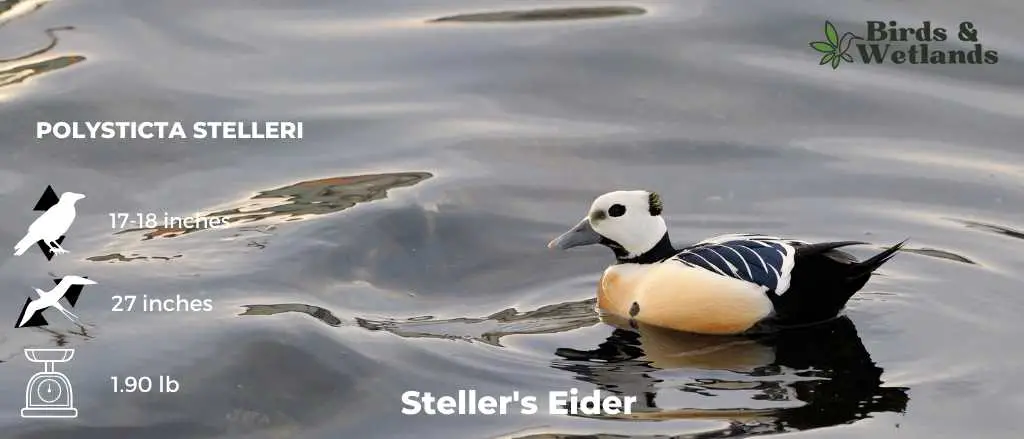
Steller’s Eider
Listen to Steller’s Eider
The Steller’s eider is a migratory Arctic diving duck that breeds along the Russian and Alaskan coasts. It is the eider species that is the rarest, tiniest and quickest flying.
The duck’s diet includes mollusks, crustaceans, other invertebrates, fish, and small aquatic animals. They can be found in the ocean and on land during the summer months, but migrate to warmer climates during the winter months.
The habitat of this bird includes rocky coasts, islands, or open tundra areas with freshwater ponds or lakes. This bird can be found in Russia, Alaska, Canada, Greenland, Iceland, Norway, and Sweden.
They nest in April through June before migrating back to their wintering grounds in September through October.
Steller’s Eiders have been listed as critically endangered by the IUCN due to loss of habitat due to climate change (melting sea ice) and hunting for food by humans who live in their breeding area (Alaska). Since 1994 because there are less than 50 breeding pairs left in the wild.
Scientific Name: Polysticta stelleri
Height: 430–460 mm (17–18 in)
Wingspan: 690 mm (27 in)
Weight: 860 g (1.90 lb)

Surf Scoter
Listen to Surf Scoter
The Surf Scoter is a medium-sized sea duck black head, a colorful bill and white patches on the nape and forehead. They are “molt migrants,” meaning they migrate to an area where they may molt their flying feathers after nesting.
The Surf Scoter is an excellent swimmer, with webbed feet that allow it to dive after fish. They are able to dive deep into the ocean to find food, but they can only stay underwater for about 1 minute before having to come up for air.
The Surf Scoter’s diet consists of fish such as sand eels, anchovies, capelin, smelt, and herring. At times they can also feed on crustaceans such as krill or shrimp. It uses its bill to filter out small organisms from the water as it swims along the surface of the ocean.
The Surf Scoter breeds on Arctic coasts from Greenland to Alaska, but most populations migrate south to winter off California and Mexico. They can also be found along the coastlines of South America, Australia, New Zealand, and Japan.
Scientific Name: Melanitta perspicillata
Length:
Male: 48 cm (19 in)
Female: 44 cm (17 in)
Wingspan: 29.9-30.3 in (76-77 cm)
Weight:
Male: 1,050 g (2.31 lb)
Female: 900 g (2.0 lb)
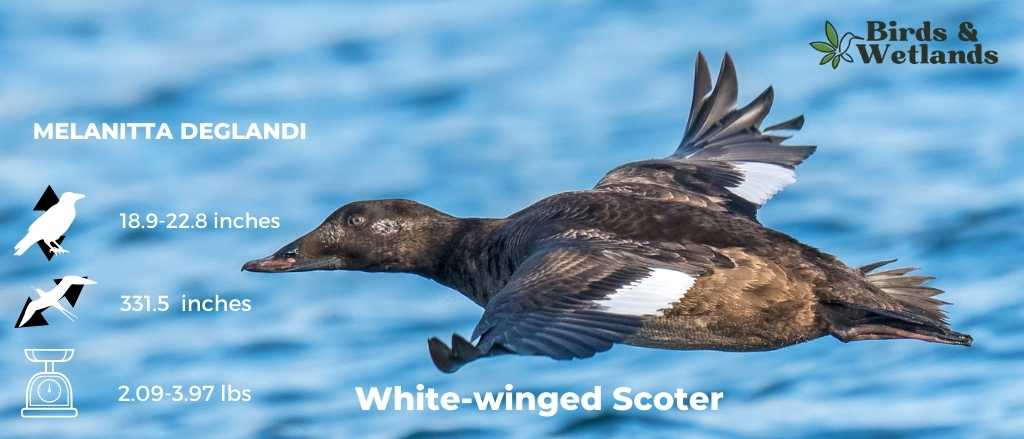
White-winged Scoter
Listen to White-winged Scoter
The White-winged Scoter is classified as an “oceanic” bird because it spends most of its time in marine waters. They have white feathers on their wings and are named after the white patch on their back. It is a medium-sized duck that has a black head, neck, and upper body, with a white breast and belly. The rest of its plumage is dark brown.
They feed primarily on mollusks, crustaceans, and fish, which they find by sweeping their bills side to side through the water in search of prey. When this happens, you’ll hear them make a loud clacking noise with their bills—which is how they got their name “scoter”.
It prefers to make its home near the coastlines of North America, Europe, and Asia. They can be found in large groups of other waterfowl but prefer to keep themselves separate from them.
They are migratory birds that make seasonal journeys between northern Canada and Mexico each spring/summer season before returning south for the winter months (December through April).
Scientific Name: Melanitta deglandi
Length: 18.9-22.8 in (48-58 cm)
Wingspan: 31.5 in (80 cm).
Weight: 33.5-63.5 oz (950-1800 g)

Wood Duck
Listen to Wood Duck
The Wood Duck is a medium-sized duck that has a long body, a short neck, and a large head. It has black plumage with white patches on its wings and tail, as well as its bill. It also has a bright red patch of skin at the base of its bill.
The Wood Duck (Aix sponsa) is a member of the Anatidae family and is native to North America. It ranges from southern Canada all the way down to Panama.
They are omnivores meaning they eat both plants such as cherries and grapes, aquatic plants such as pondweeds and water lilies, and animals but are mainly insectivores feeding on small invertebrates such as insects and worms.
They live in wooded areas near water sources like ponds, lakes, rivers, streams, marshes, and swamps. They live in large flocks during the breeding season and then move to smaller groups during migration or winter.
The population of the wood duck was in serious decline in the late 19th century as a result of severe habitat loss and market hunting both for meat and plumage for the ladies’ hat market in Europe. By the beginning of the 20th century, wood ducks had virtually disappeared from much of their former range.
Scientific Name: Aix sponsa
Height: 47 to 54 cm (19 to 21 in) ( or 1.5 feet max.)
Wingspan: 66 to 73 cm (26 to 29 in)
Weight: 454-862 g (16.0-30.4 oz)
Canvasback (Aythya valisineria)
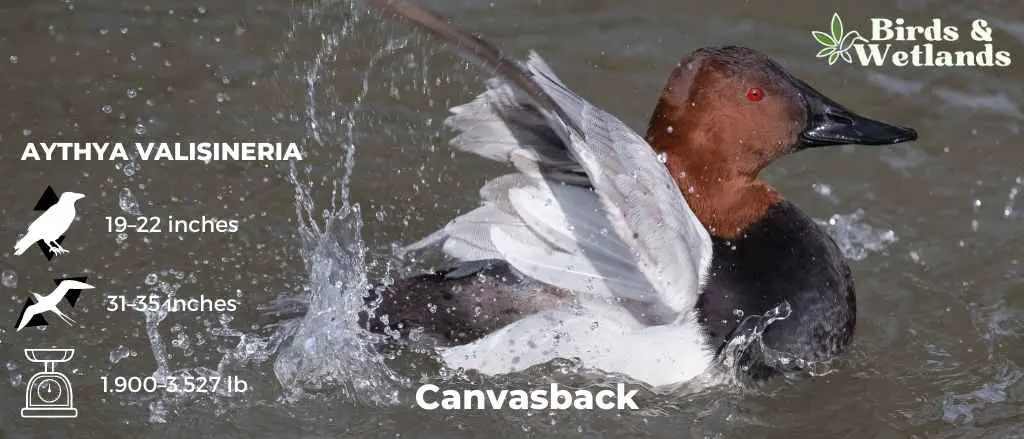
Canvasback
Canvasbacks are large diving ducks that have a dark head and neck and a white body and are found all over the Northern Hemisphere.
Scientific Name: Aythya valisineria
Height: 48–56 cm (19–22 in)
Wingspan: 79–89 cm (31–35 in)
Weight: 862–1,600 g (1.900–3.527 lb)
Canvasback Description
The Canvasback makes a royal appearance. The male’s white back and flanks reminded English settlers of canvas fabric, hence the name. With a red-brown head and flashing crimson eyes, the drake (male) is a striking appearance.
It is a medium-sized duck that is easily recognizable by its distinct head pattern. Its bill is mostly orange with a black tip, and it has a dark brown head and neck. Its body is primarily white with black speckles on the wings, back, and sides.
Canvasback Sound
Canvasback Habitat & Range
The habitat of the canvasback includes lakes and ponds in North America, Europe, Asia, and Australia. Canvasbacks breed in North America’s Prairie Pothole Region. They like to build their nests above water in permanent Prairie wetlands with emergent plants such as cattails and bulrushes for protection.

Canvasback
Canvasback Diet
The canvasback is a versatile feeder that can consume plants ranging in size from tiny strands to large leafy growths. It has been seen feeding upon countless species of aquatic vegetation, including pond weeds and wild celery as well! The bird also takes interest in snails or other mollusks for food sources not related directly with waterfowl production- think gastropods (slugs & snail shells) insects , small fish – which it may catch while hunting its own kind underwater among foliage near shallow coastal waters where these animals breed.
Canvasback Nesting
They nest in tree cavities and will lay anywhere from 8-15 eggs. The female incubates the eggs for 28-30 days while the male sits on them to keep them warm. When they hatch they are able to swim immediately!
Green-winged Teal (Anas crecca)
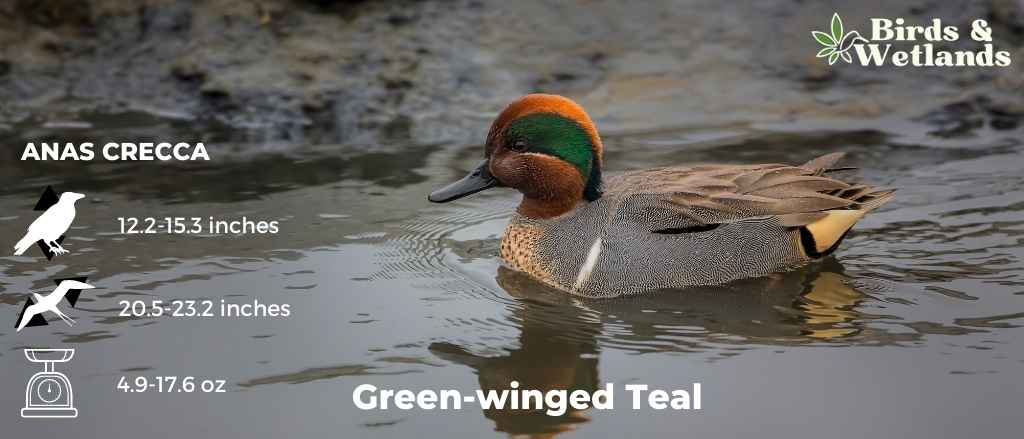
It is a common and ubiquitous duck that breeds across northern North America. They are also known as “green wings” or “bluebills”. For a long time, it was believed conspecific with the Eurasian teal, but it has subsequently been classified as a separate species.
Scientific Name: Anas crecca
Height: 12.2-15.3 in (31-39 cm)
Wingspan: 20.5-23.2 in (52-59 cm)
Weight: 4.9-17.6 oz (140-500 g)
Description
It has an olive-brown back, a white breast, and a brown head with a white stripe above the eye. The male has a green speculum (the outer web of feathers on the wings) that extends from his shoulders to his tail. The female’s speculum is more subdued than that of the male; it appears as a pale buff color, not greenish like the male’s.
Sound
Habitat & Range
This duck has been introduced into many parts of Europe and Asia where it has become an invasive species due to its ability to adapt to new environments quickly. As a result, it is now considered one of the world’s most invasive birds according to BirdLife International’s Global Invasive Species Database (GISD).
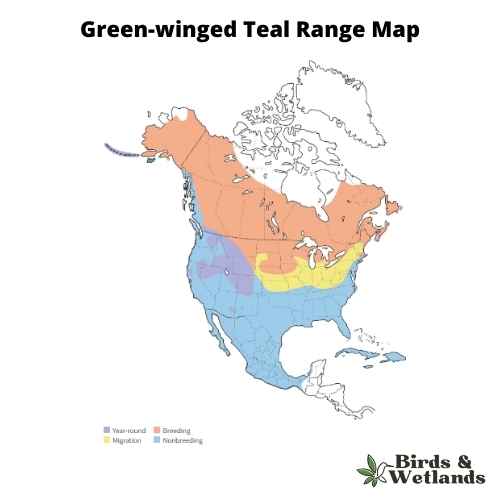
Diet
In the winter months, they eat seeds, grains, and insects but during the summer months they switch over to eating aquatic plants like pondweeds, watercress, and duckweed which make up about 70% of their diet.
Green-winged Teal Nesting
The Green-winged teal nests on the ground near water sources such as streams or ponds. The female lays between 7-15 eggs per clutch (which means cluster) which incubate for 25 days before hatching out into ducklings!
Redhead (Aythya americana)
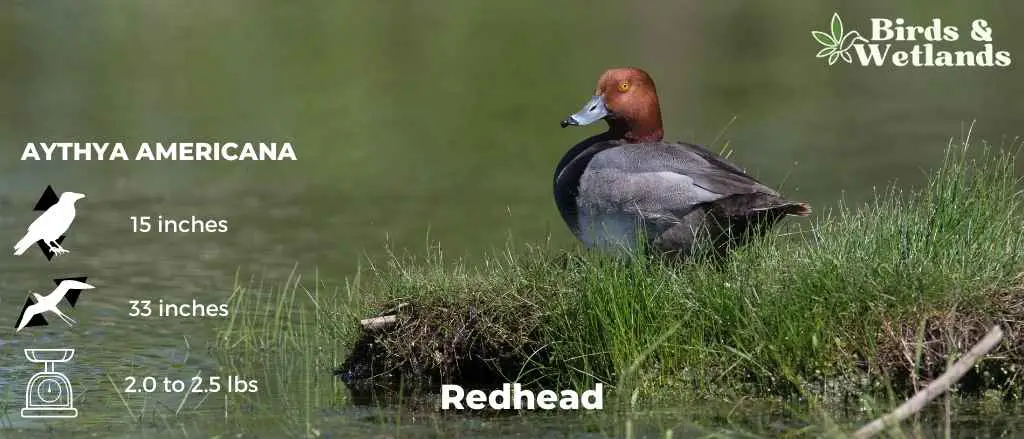
Redhead
The redhead duck is one of the most striking birds in North America. They are easily recognizable by their bright orange-red heads and chests, which contrast sharply with their pale grey bodies. Redheads are also known for their distinctive call, which sounds like a high-pitched whistle.
Scientific Name: Aythya americana
Length: 37 cm (15 in)
Wingspan: 84 cm (33 in)
Weight: 2.0 to 2.5 lbs
Redhead Description
Redhead Ducks are a common sight at the pond. They have a red head and white body, with some gray feathers on their wings. They are about the size of a mallard duck, but have shorter legs and a longer bill.
Redhead Sound
Redhead Habitat & Range
Redheads can be found throughout North America, with the exception of southern Mexico and parts of the southeastern United States. They are most common in coastal areas and large rivers. In fact, many people mistake them for musk ducks when they see them in freshwater habitats. Redheads tend to prefer shallow waters with plenty of vegetation near shorelines or riverbanks instead of deeper water where musk ducks tend to prefer staying put.
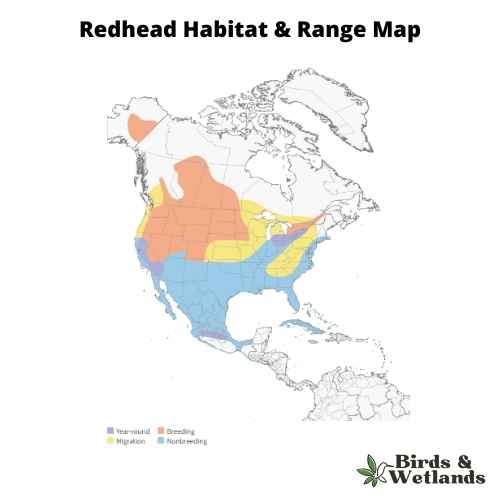
Redhead Range Map credit: https://www.allaboutbirds.org/
Redhead Diet
The redhead diet mainly consists of plant matter such as seeds, berries, shoots and buds from aquatic plants such as pondweed or cattails as well as insects such as dragonflies or small fish like minnows or smelt.
Redhead Nesting
The Redhead Duck lives on a diet of seeds and aquatic plants as well as insects and small fish. The female Redhead Duck lays between 8-12 eggs per clutch, which she then incubates for 28 days before they hatch. The male Redhead Duck will stay nearby while she is incubating her eggs and will care for them once they hatch by leading them to water where they can find food to eat.
Ring-necked Duck (Aythya collaris)

Ring-necked Duck
The Ring-necked Duck has a bright orange bill with a black tip and an olive-green head with a black mask across its eyes and down its beak. Its neck is white and speckled with gray, brown, or black patches. The rest of its body is grayish-brown to dark brown. Males have yellow eyes.
Scientific Name: Aythya collaris
Height: 15.3-18.1 in (39-46 cm)
Wingspan: 24.4-24.8 in (62-63 cm)
Weight: 17.3-32.1 oz (490-910 g)
Ring-necked Duck Description
The Ring-necked Duck is a duck that you can find in the United States and Canada, as well as in parts of Mexico.
They are omnivorous so they also eat seeds and grains when they’re available too. They eat grasses, insects such as beetles and dragonflies when they’re available, seeds, and other types of plants like duckweed, water lilies, pondweeds, and grasses that grow along water edges or in open water areas.
Ring-necked Duck Sound
Ring-necked Duck Habitat & Range
It can be found throughout North America, Central America, and northern South America. It breeds in freshwater marshes, ponds, lakes, and streams. They’re also known to breed in saltwater marshes.
They use their bills to eat these things from the bottom of the lake or pond. They also swim underwater when they eat food. It prefers freshwater marshes, lakes, ponds, streams, rivers, and estuaries near forest edges where trees provide nesting sites for the ducklings.
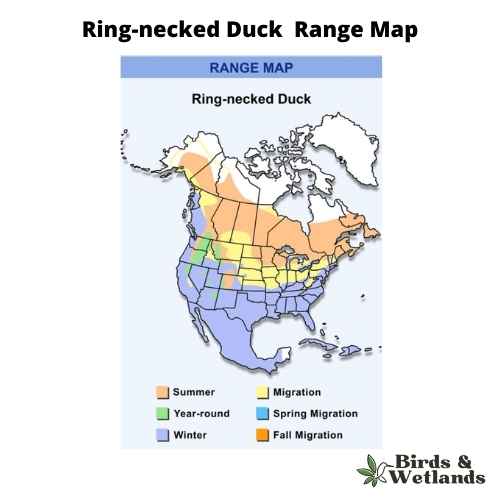
Ring-necked Duck Range Map credit: https://perceviaassets.azurewebsites.net/
Ring-necked Duck Diet
They feed on aquatic plants like pondweed as well as insects and other invertebrates. They will also eat small crustaceans such as crabs or shrimp if they can find them in their habitat.
Ring-necked Duck Nesting
During breeding season (which is usually in April or May), males will form flocks on the water while females lay eggs in nests made from grasses near shorelines or floating on debris near shorelines where there are no predators present to threaten their young hatchlings.
Tufted Duck (Aythya fuligula)

Tufted Duck
The Tufted Duck is a small diving duck found in lakes and marshes throughout most of Europe.
Scientific Name: Aythya fuligula
Height: Male: 40.6-45.7 cm Female: 40.6-45.7 cm
Wingspan: Male: 20.2-21.2 cm Female: 19.4-20.7 cm
Weight: Male: 889.6 g Female: 768.3 g
Tufted Duck Description
Tufted Duck have a distinctive crest of feathers on the top of their heads that gives them their name, along with a long, slender bill and short legs. It is usually light brown with darker wings and a white underbelly.
Tufted Duck Sound
Tufted Duck Habitat & Range
Tufted Ducks are found throughout much of Europe as well as Asia, Central Africa and parts of Australia. They breed in shallow marshes or ponds where they construct nests out of grasses and rushes.
The population of this bird has been steadily declining due to habitat loss due to human development
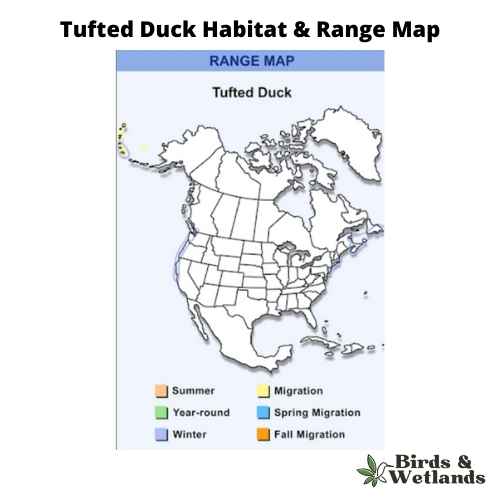
Tufted Duck Range Map credit: https://assets.whatbird.com/
Tufted Duck Diet
Tufted Ducks are omnivorous feeders, eating insects such as dragonflies, beetles, and flies as well as seeds from plants such as tall grasses. It also feeds on frogs, worms, and other small creatures that live in the mud at the bottom of ponds and lakes.
Tufted Duck Nesting
Tufted Ducks make their nests in tree cavities above ground level or near water sources where they can be easily accessed by their young once they hatch out of their eggs (which are laid in May). These birds are monogamous pairs who keep each other company throughout their lives together; however this does not mean that they mate for life: if one dies then the other will find another mate to replace him/her!
Where to Watch Ducks in Alaska?
Visitors to Alaska looking to catch a glimpse of some of the state’s iconic wildlife should head to one of the many areas and interior regions where ducks can be found.
The Yukon-Kuskokwim Delta is a great place to see a variety of different duck species, including mergansers, goldeneyes, and harlequin ducks. The Arctic Coastal Plain is another excellent spot for birdwatching, as it is home to a large population of waterfowl, including eiders, scoters, and spectacled eiders.
For those looking to get away from it all, the Bristol Bay Lowlands and Aleutian Islands offer a remote and peaceful setting in which to view ducks.
And finally, the Yukon Flats and Tanana/Kuskokwim Valley are both great places to see a variety of different duck species. Additionally, many diving ducks live along the Alaskan coast.
Are There Any Resident Ducks In Alaska?
Alaska is home to many different types of dabbling and sea ducks, but not all of them are resident species. While mallards and harlequin ducks can be found in Alaska all year round, other ducks only visit during the summer months. This is because Alaska’s climate is too cold for some ducks to survive the winter.
Resident duck species are well adapted to the cold, with thick feathers that provide insulation against the chilly weather. In addition, many resident ducks are able to find food sources even when lakes and ponds are frozen over.
Duck Hunting in AK
You can hunt ducks in Alaska but there are a few things to keep in mind. While most parts of Alaska do not require a permit to hunt waterfowl, some regions do. Additionally, the season for hunting waterfowl varies depending on the area, so be sure to check the regulations with the Alaska Department of Fish and Game before you go.
With these things in mind, you should have no problem enjoying a successful duck hunt in the Last Frontier.
Can You Shoot a Ducks in AK?
Duck hunting is a popular sport in Alaska, and there are several laws and regulations in place to help ensure a safe and successful hunt. For example, only non-toxic shots approved by the U.S. Fish and Wildlife Service are allowed in order to protect the ducks and other wildlife.
Additionally, hunting from any type of aircraft or with the aid of recorded bird calls is strictly prohibited.
There are other regulations you need to adhere to ensure that the hunt is fair and respectful of the ducks and their habitat.
Where Can I Hunt Ducks in AK?
Alaska is well-known for its duck hunting, and there are many great places to bag a bird. One popular spot is Island X in the Bering Sea. The island is home to a variety of ducks, particularly King Eider. The island also provides stunning scenery, with its volcanic peaks and rocky shores.
Another great place to hunt ducks is in Prince William Sound. This area is known for its large populations of birds, as well as its scenic views of glaciers and mountains. Duck hunting season in Alaska is usually from September to December.
Conclusion on Ducks in AK
If you’re looking for a great place to watch ducks, Alaska is definitely worth considering. With 39 species of ducks calling the state home and over 170 millions of acres of wetlands and boreal forest that provide breeding habitat to various species of birds, you’re sure to see some interesting and beautiful birds.
Additionally, the state also supports breeding populations of the Aleutian cackling geese, Pacific white-fronted geese and the dusky Canada geese.


